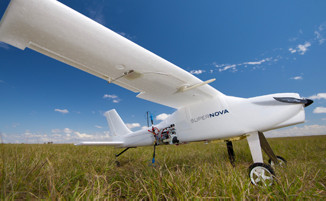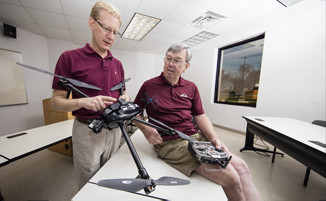The Aviation Program is producing cutting-edge drone research and hands on field operations
that will improve agriculture—a major economic influence in northeast Louisiana.
SuperNova heavy lift drone with a Micasense multi-
spectral camera. Property of ULM.
Unmanned aerial systems (UAS), or more commonly known as drones, are rapidly increasing
in popularity. For years, UAS technology has been applied in various military field
operations, including aerial photography, combat, and surveillance. More recently,
drones have also found their way into the hands of many private citizens for recreational
use.
But far beyond their recreational appeal, drones can actually provide farmers with
important technology that will ultimately help determine crop health and facilitate
agricultural productivity overall. And while this might be news to many local farmers,
that’s certainly not the case in Japan.
In the early 1980s, Japan solicited the help of Yamaha to develop an unmanned helicopter
for crop dusting applications. This initiative led to the development of Yamaha’s
R-50 and RMAX, two unmanned helicopters that have been used successfully by Japanese
farmers for decades. The U.S. is currently pushing to implement UAS systems in a variety
of contexts, including farming. And ULM is playing an integral role in the research
and development behind it all.
In 2013, ULM’s Aviation Program introduced the state of Louisiana’s first concentration
in UAS technology. It has already expanded to include a Precision Agriculture and
Research Center (PARC), which is dedicated to producing research in agriculture—a
major economic influence in our region. The research ultimately seeks to discover
ways in which various sensor technologies can be used to determine crop health.
And crop health is no small issue. In fact, the livelihood of local farmers depends
on it. Parasites, feral hogs, shortage of light, drought, and nutrition deficiency
are among many of the causes of crop damage. In a recent study, it was estimated that
feral hogs alone caused over $74 million in crop damage in the state of Louisiana
in 2013. Researchers agree that total crop damage in the state is well in excess of
$1 billion, although exact financial loss is difficult to determine.
So where do drones come into play?
Dr. Chenoweth (left) and Mr. Paul Karlowitz (right),
director of UAS flight operations.
According to Dr. Sean Chenoweth, ULM associate professor in the college of business
and socials sciences, and director of research for the PARC, UAS technology is an
important tool that can assist precision agriculture by detecting problems with crops
by using near infrared mapping technology.
“Once a problem is detected, field inspection is necessary to determine if there is
a water shortage or surplus, bug pests, fungus or nutrient deficiency,” says Dr. Chenoweth.
“The traditional method has been to treat the entire field for a problem that might
just be in one isolated place. Precision agriculture seeks to treat only the affected
areas instead of wasting chemicals on the entire field.”
An unmanned aerial system consists of: a ground control station (laptop with antenna),
software to program and fly the drone, autopilot software and hardware, multi-spectral
camera (green, red, near-infrared), and image processing software to mosaic (stitch)
the hundreds of images into one continuous map.
After the drone has been programmed for flight and launched, it will fly over an agricultural
field autonomously collecting multi-spectral images. The camera takes a picture about
every 2 seconds. A 50 acre field takes about 200 images to cover. When the drone has
finished taking pictures of the field it will also automatically land in a designated
area. Then the images are downloaded to a computer for processing into a single mosaicked
image. Healthy vegetation reflects large amounts of near-infrared radiation so the
red and near-infrared channels are used to create a crop health map of the field.
The most common formula used is the Normalized Difference Vegetation Index (NDVI),
which ranges from -1 no vegetation to +1 for healthy vegetation.
According to one local farmer, the real utility of drone technology lies in its ability
to do what farmers cannot physically do. “We have to micromanage things now in a way
that we have never done before,” says Edward Greer, who farms in three different parishes
throughout northeast Louisiana. “A farm now is larger than it was twenty years ago,
so in an effort to minimize expenses, we focus on precision agriculture, of which
drone technology is a part. Farmers don’t have time to manually walk fields any more
and so the use of drones for precision agriculture applications is highly important.”
But getting approval to operate agriculture drones is not as straightforward as many
would think. According to the Federal Aviation Administration (FAA), the requirements
needed for farmers to operate an unmanned aircraft or drone for their business include:
a Section 333 grant of exemption, a Certificate of Waiver or Authorization (COA),
an aircraft registered with the FAA, and a pilot with an FAA airman certificate. The
processing time for an application for a Section 333 Exemption alone can take up to
120 days. Thus, the regulations as set by the FAA are prohibitive for some, and potentially
discouraging to many.
But, according to Dr. Chenoweth, the benefits of drone technology for agricultural
applications are countless. “I think most farmers will want to use UAS to manage their
crops and livestock once they start hearing success stories of the potential of this
technology from other farmers,” says Dr. Chenoweth. “Right now, this is an industry
in its inception. But it has the potential of becoming a large-scale industry, one
that positively impacts farmers across our nation.”
ULM has positioned itself to play a major role in this industry in a unique way: by
educating local farmers. The UAS concentration is of course designed to encourage
students to immerse themselves in the UAS technology and to keep abreast and comply
with all of the FAA regulations. But local farmers are also being encouraged to get
involved. For example, the Aviation Department at ULM continues has offered a free
UAS and agriculture seminar, covering topics such as ground control station programming,
flight operations, field mapping and image stitching (mosaicking). And this seminar,
which is funded by the Delta Regional Authority, is one of many seminars to come.
ULM’s efforts to educate the public on drone technology are not going unnoticed. Edward
D. Markle, a member of the Louisiana Board of Regents, who is also a licensed FAA
flight instructor and commercial pilot, says this is precisely what sets ULM’s Aviation
Program apart from others. “One of the problems about UAS technology is that the farmer
has not caught up to the technology. That is, many farmers know about drones, but
they have limited or no knowledge about how to use them. This is precisely where I
see ULM making a lasting difference—by opening up the classroom to educate local farmers.”
ULM has been granted a Certificate of Authorization (COA) by the FAA for aeronautical
research on a 50 acre plot of land in Sterlington, although the Aviation Program is
pushing for regional approval.
To learn more about the UAS Program, please visit ulm.edu/cbss/aviation.


